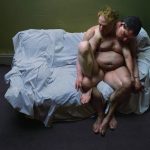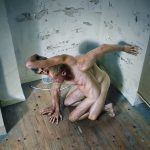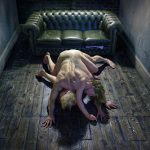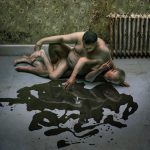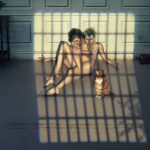-

Foreign Body
Limited edition Lambda print; sizes vary.
This series of photographs, entitled ‘Foreign Body’, explore the relationship between the body and identity whilst also questioning traditional conceptions of corporeality and of the male nude.
In these pictures the body is presented as unstable, ambiguous, permeable, and lacking a singular coherent form. I depict the body not as a protective envelope that defines and unifies our limits, but rather, a place of interface between the subject and the other. The body’s boundaries are questioned and the closure and integrity of the self is placed in doubt.
Figures intersect, seeming to inhabit the same space rendering it unclear where one figure ends and another begins. This results in a kind of fragmentation and incoherence of the body leading to questions over the coherence of the self in relation to the body. The body is no longer the space that secures the idea of self, it is the domain where the self is contested and called into question.Corporeality is evoked in every aspect of the image, from the obvious physicality of the naked figures, to the decaying rooms they inhabit, the exposed pipe work and peeling wallpaper seeming to evoke wounded flesh, flaking skin and sweating bodies. The sense of the fleshiness of the world seeps beyond the boundaries of the figures into their environment – a world made flesh.
The bodies themselves are subject to unsentimental scrutiny. Every pour, wrinkle and crease is set forth. Rejecting the long tradition of the idealised nude in art history, I present the figure with all its fascinating flaws in tact. Its ageing frailty, its beautiful textures and colours, its translucent skin over pulsing blue veins all contributing to an image of the body that is rich with life and vitality and yet whose frail mortality is ever present.
Photography is a particularly appropriate medium for my purposes given its historical associations and recent digital transformation. Photography once appeared to provide us with causally generated ‘truthful’ records of things in the world. It reinforced the Cartesian idea of a disembodied self, capable of attaining certain knowledge from a stable viewpoint. In the digital age this definition of photography has collapsed, yet the belief in the photograph as a faithful record of reality stubbornly persists. I see an analogous shift in modern understandings of the self. Cartesian notions of self – stable, ordered, discrete, disembodied, permanent, unchanging – have given way to a fragmented self – unstable, constantly in flux, embodied, impermanent, fluid.
In these photographs the idea of photography as instantaneous nature of photography has been turned on its head. Taken from several points of view, composed of multiple shots, compressing several instances into a single frame, they are compositions of unified fragments. The sense of an illusory wholeness masking a fractured and uncertain reality is embedded in the very structure of the photographs and functions as a metaphor for the illusion of wholeness in the fragmented self.
-

Foreign Body
Limited edition Lambda print; sizes vary.
This series of photographs, entitled ‘Foreign Body’, explore the relationship between the body and identity whilst also questioning traditional conceptions of corporeality and of the male nude.
In these pictures the body is presented as unstable, ambiguous, permeable, and lacking a singular coherent form. I depict the body not as a protective envelope that defines and unifies our limits, but rather, a place of interface between the subject and the other. The body’s boundaries are questioned and the closure and integrity of the self is placed in doubt.
Figures intersect, seeming to inhabit the same space rendering it unclear where one figure ends and another begins. This results in a kind of fragmentation and incoherence of the body leading to questions over the coherence of the self in relation to the body. The body is no longer the space that secures the idea of self, it is the domain where the self is contested and called into question.Corporeality is evoked in every aspect of the image, from the obvious physicality of the naked figures, to the decaying rooms they inhabit, the exposed pipe work and peeling wallpaper seeming to evoke wounded flesh, flaking skin and sweating bodies. The sense of the fleshiness of the world seeps beyond the boundaries of the figures into their environment – a world made flesh.
The bodies themselves are subject to unsentimental scrutiny. Every pour, wrinkle and crease is set forth. Rejecting the long tradition of the idealised nude in art history, I present the figure with all its fascinating flaws in tact. Its ageing frailty, its beautiful textures and colours, its translucent skin over pulsing blue veins all contributing to an image of the body that is rich with life and vitality and yet whose frail mortality is ever present.
Photography is a particularly appropriate medium for my purposes given its historical associations and recent digital transformation. Photography once appeared to provide us with causally generated ‘truthful’ records of things in the world. It reinforced the Cartesian idea of a disembodied self, capable of attaining certain knowledge from a stable viewpoint. In the digital age this definition of photography has collapsed, yet the belief in the photograph as a faithful record of reality stubbornly persists. I see an analogous shift in modern understandings of the self. Cartesian notions of self – stable, ordered, discrete, disembodied, permanent, unchanging – have given way to a fragmented self – unstable, constantly in flux, embodied, impermanent, fluid.
In these photographs the idea of photography as instantaneous nature of photography has been turned on its head. Taken from several points of view, composed of multiple shots, compressing several instances into a single frame, they are compositions of unified fragments. The sense of an illusory wholeness masking a fractured and uncertain reality is embedded in the very structure of the photographs and functions as a metaphor for the illusion of wholeness in the fragmented self.
-

Foreign Body
Limited edition Lambda print; sizes vary.
This series of photographs, entitled ‘Foreign Body’, explore the relationship between the body and identity whilst also questioning traditional conceptions of corporeality and of the male nude.
In these pictures the body is presented as unstable, ambiguous, permeable, and lacking a singular coherent form. I depict the body not as a protective envelope that defines and unifies our limits, but rather, a place of interface between the subject and the other. The body’s boundaries are questioned and the closure and integrity of the self is placed in doubt.
Figures intersect, seeming to inhabit the same space rendering it unclear where one figure ends and another begins. This results in a kind of fragmentation and incoherence of the body leading to questions over the coherence of the self in relation to the body. The body is no longer the space that secures the idea of self, it is the domain where the self is contested and called into question.Corporeality is evoked in every aspect of the image, from the obvious physicality of the naked figures, to the decaying rooms they inhabit, the exposed pipe work and peeling wallpaper seeming to evoke wounded flesh, flaking skin and sweating bodies. The sense of the fleshiness of the world seeps beyond the boundaries of the figures into their environment – a world made flesh.
The bodies themselves are subject to unsentimental scrutiny. Every pour, wrinkle and crease is set forth. Rejecting the long tradition of the idealised nude in art history, I present the figure with all its fascinating flaws in tact. Its ageing frailty, its beautiful textures and colours, its translucent skin over pulsing blue veins all contributing to an image of the body that is rich with life and vitality and yet whose frail mortality is ever present.
Photography is a particularly appropriate medium for my purposes given its historical associations and recent digital transformation. Photography once appeared to provide us with causally generated ‘truthful’ records of things in the world. It reinforced the Cartesian idea of a disembodied self, capable of attaining certain knowledge from a stable viewpoint. In the digital age this definition of photography has collapsed, yet the belief in the photograph as a faithful record of reality stubbornly persists. I see an analogous shift in modern understandings of the self. Cartesian notions of self – stable, ordered, discrete, disembodied, permanent, unchanging – have given way to a fragmented self – unstable, constantly in flux, embodied, impermanent, fluid.
In these photographs the idea of photography as instantaneous nature of photography has been turned on its head. Taken from several points of view, composed of multiple shots, compressing several instances into a single frame, they are compositions of unified fragments. The sense of an illusory wholeness masking a fractured and uncertain reality is embedded in the very structure of the photographs and functions as a metaphor for the illusion of wholeness in the fragmented self.
-

Foreign Body
Limited edition Lambda print; sizes vary.
This series of photographs, entitled ‘Foreign Body’, explore the relationship between the body and identity whilst also questioning traditional conceptions of corporeality and of the male nude.
In these pictures the body is presented as unstable, ambiguous, permeable, and lacking a singular coherent form. I depict the body not as a protective envelope that defines and unifies our limits, but rather, a place of interface between the subject and the other. The body’s boundaries are questioned and the closure and integrity of the self is placed in doubt.
Figures intersect, seeming to inhabit the same space rendering it unclear where one figure ends and another begins. This results in a kind of fragmentation and incoherence of the body leading to questions over the coherence of the self in relation to the body. The body is no longer the space that secures the idea of self, it is the domain where the self is contested and called into question.Corporeality is evoked in every aspect of the image, from the obvious physicality of the naked figures, to the decaying rooms they inhabit, the exposed pipe work and peeling wallpaper seeming to evoke wounded flesh, flaking skin and sweating bodies. The sense of the fleshiness of the world seeps beyond the boundaries of the figures into their environment – a world made flesh.
The bodies themselves are subject to unsentimental scrutiny. Every pour, wrinkle and crease is set forth. Rejecting the long tradition of the idealised nude in art history, I present the figure with all its fascinating flaws in tact. Its ageing frailty, its beautiful textures and colours, its translucent skin over pulsing blue veins all contributing to an image of the body that is rich with life and vitality and yet whose frail mortality is ever present.
Photography is a particularly appropriate medium for my purposes given its historical associations and recent digital transformation. Photography once appeared to provide us with causally generated ‘truthful’ records of things in the world. It reinforced the Cartesian idea of a disembodied self, capable of attaining certain knowledge from a stable viewpoint. In the digital age this definition of photography has collapsed, yet the belief in the photograph as a faithful record of reality stubbornly persists. I see an analogous shift in modern understandings of the self. Cartesian notions of self – stable, ordered, discrete, disembodied, permanent, unchanging – have given way to a fragmented self – unstable, constantly in flux, embodied, impermanent, fluid.
In these photographs the idea of photography as instantaneous nature of photography has been turned on its head. Taken from several points of view, composed of multiple shots, compressing several instances into a single frame, they are compositions of unified fragments. The sense of an illusory wholeness masking a fractured and uncertain reality is embedded in the very structure of the photographs and functions as a metaphor for the illusion of wholeness in the fragmented self.
-
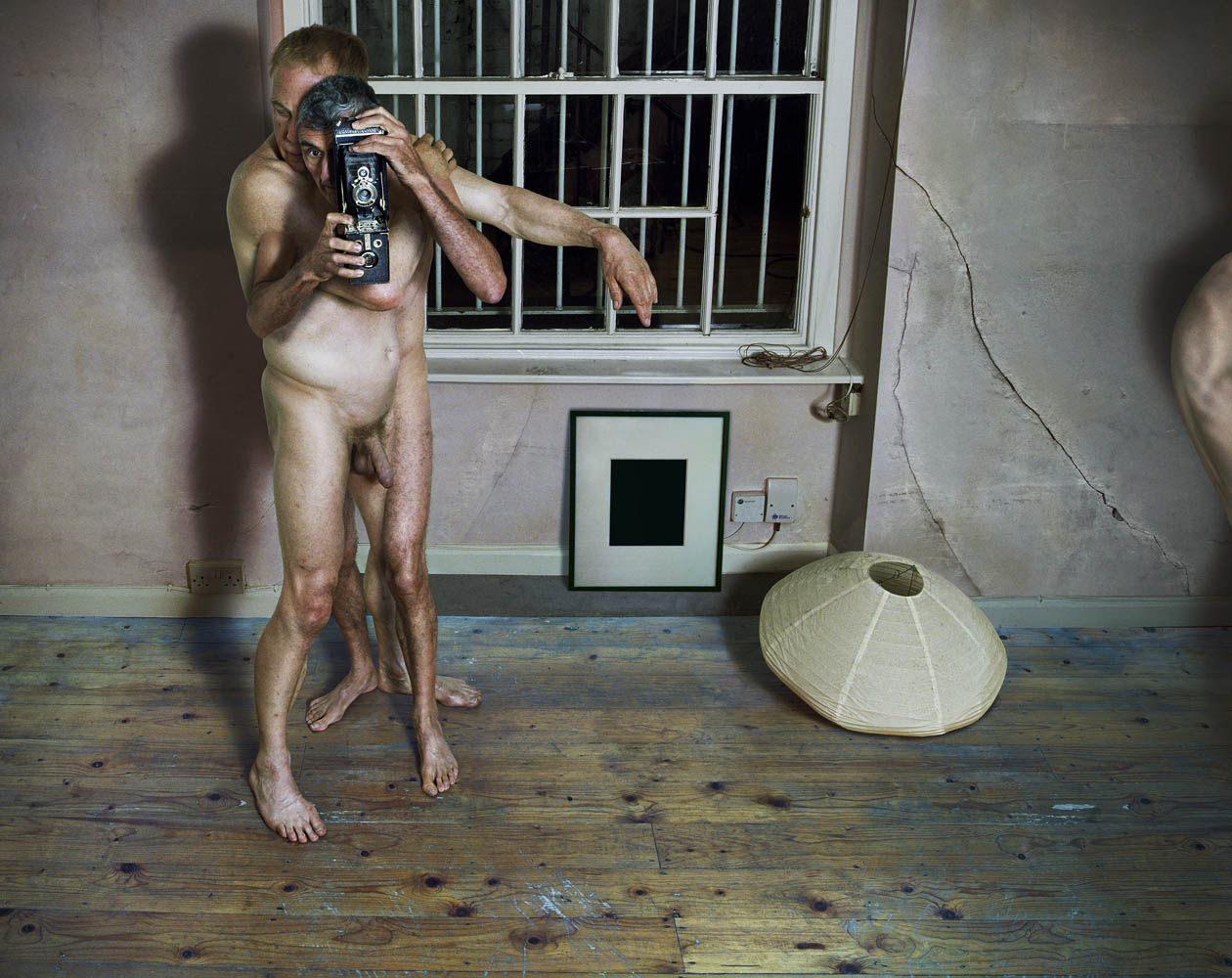
Foreign Body
Limited edition Lambda print; sizes vary.
This series of photographs, entitled ‘Foreign Body’, explore the relationship between the body and identity whilst also questioning traditional conceptions of corporeality and of the male nude.
In these pictures the body is presented as unstable, ambiguous, permeable, and lacking a singular coherent form. I depict the body not as a protective envelope that defines and unifies our limits, but rather, a place of interface between the subject and the other. The body’s boundaries are questioned and the closure and integrity of the self is placed in doubt.
Figures intersect, seeming to inhabit the same space rendering it unclear where one figure ends and another begins. This results in a kind of fragmentation and incoherence of the body leading to questions over the coherence of the self in relation to the body. The body is no longer the space that secures the idea of self, it is the domain where the self is contested and called into question.Corporeality is evoked in every aspect of the image, from the obvious physicality of the naked figures, to the decaying rooms they inhabit, the exposed pipe work and peeling wallpaper seeming to evoke wounded flesh, flaking skin and sweating bodies. The sense of the fleshiness of the world seeps beyond the boundaries of the figures into their environment – a world made flesh.
The bodies themselves are subject to unsentimental scrutiny. Every pour, wrinkle and crease is set forth. Rejecting the long tradition of the idealised nude in art history, I present the figure with all its fascinating flaws in tact. Its ageing frailty, its beautiful textures and colours, its translucent skin over pulsing blue veins all contributing to an image of the body that is rich with life and vitality and yet whose frail mortality is ever present.
Photography is a particularly appropriate medium for my purposes given its historical associations and recent digital transformation. Photography once appeared to provide us with causally generated ‘truthful’ records of things in the world. It reinforced the Cartesian idea of a disembodied self, capable of attaining certain knowledge from a stable viewpoint. In the digital age this definition of photography has collapsed, yet the belief in the photograph as a faithful record of reality stubbornly persists. I see an analogous shift in modern understandings of the self. Cartesian notions of self – stable, ordered, discrete, disembodied, permanent, unchanging – have given way to a fragmented self – unstable, constantly in flux, embodied, impermanent, fluid.
In these photographs the idea of photography as instantaneous nature of photography has been turned on its head. Taken from several points of view, composed of multiple shots, compressing several instances into a single frame, they are compositions of unified fragments. The sense of an illusory wholeness masking a fractured and uncertain reality is embedded in the very structure of the photographs and functions as a metaphor for the illusion of wholeness in the fragmented self.
-

Foreign Body
Limited edition Lambda print; sizes vary.
This series of photographs, entitled ‘Foreign Body’, explore the relationship between the body and identity whilst also questioning traditional conceptions of corporeality and of the male nude.
In these pictures the body is presented as unstable, ambiguous, permeable, and lacking a singular coherent form. I depict the body not as a protective envelope that defines and unifies our limits, but rather, a place of interface between the subject and the other. The body’s boundaries are questioned and the closure and integrity of the self is placed in doubt.
Figures intersect, seeming to inhabit the same space rendering it unclear where one figure ends and another begins. This results in a kind of fragmentation and incoherence of the body leading to questions over the coherence of the self in relation to the body. The body is no longer the space that secures the idea of self, it is the domain where the self is contested and called into question.Corporeality is evoked in every aspect of the image, from the obvious physicality of the naked figures, to the decaying rooms they inhabit, the exposed pipe work and peeling wallpaper seeming to evoke wounded flesh, flaking skin and sweating bodies. The sense of the fleshiness of the world seeps beyond the boundaries of the figures into their environment – a world made flesh.
The bodies themselves are subject to unsentimental scrutiny. Every pour, wrinkle and crease is set forth. Rejecting the long tradition of the idealised nude in art history, I present the figure with all its fascinating flaws in tact. Its ageing frailty, its beautiful textures and colours, its translucent skin over pulsing blue veins all contributing to an image of the body that is rich with life and vitality and yet whose frail mortality is ever present.
Photography is a particularly appropriate medium for my purposes given its historical associations and recent digital transformation. Photography once appeared to provide us with causally generated ‘truthful’ records of things in the world. It reinforced the Cartesian idea of a disembodied self, capable of attaining certain knowledge from a stable viewpoint. In the digital age this definition of photography has collapsed, yet the belief in the photograph as a faithful record of reality stubbornly persists. I see an analogous shift in modern understandings of the self. Cartesian notions of self – stable, ordered, discrete, disembodied, permanent, unchanging – have given way to a fragmented self – unstable, constantly in flux, embodied, impermanent, fluid.
In these photographs the idea of photography as instantaneous nature of photography has been turned on its head. Taken from several points of view, composed of multiple shots, compressing several instances into a single frame, they are compositions of unified fragments. The sense of an illusory wholeness masking a fractured and uncertain reality is embedded in the very structure of the photographs and functions as a metaphor for the illusion of wholeness in the fragmented self.
-

Foreign Body
Limited edition Lambda print; sizes vary.
This series of photographs, entitled ‘Foreign Body’, explore the relationship between the body and identity whilst also questioning traditional conceptions of corporeality and of the male nude.
In these pictures the body is presented as unstable, ambiguous, permeable, and lacking a singular coherent form. I depict the body not as a protective envelope that defines and unifies our limits, but rather, a place of interface between the subject and the other. The body’s boundaries are questioned and the closure and integrity of the self is placed in doubt.
Figures intersect, seeming to inhabit the same space rendering it unclear where one figure ends and another begins. This results in a kind of fragmentation and incoherence of the body leading to questions over the coherence of the self in relation to the body. The body is no longer the space that secures the idea of self, it is the domain where the self is contested and called into question.Corporeality is evoked in every aspect of the image, from the obvious physicality of the naked figures, to the decaying rooms they inhabit, the exposed pipe work and peeling wallpaper seeming to evoke wounded flesh, flaking skin and sweating bodies. The sense of the fleshiness of the world seeps beyond the boundaries of the figures into their environment – a world made flesh.
The bodies themselves are subject to unsentimental scrutiny. Every pour, wrinkle and crease is set forth. Rejecting the long tradition of the idealised nude in art history, I present the figure with all its fascinating flaws in tact. Its ageing frailty, its beautiful textures and colours, its translucent skin over pulsing blue veins all contributing to an image of the body that is rich with life and vitality and yet whose frail mortality is ever present.
Photography is a particularly appropriate medium for my purposes given its historical associations and recent digital transformation. Photography once appeared to provide us with causally generated ‘truthful’ records of things in the world. It reinforced the Cartesian idea of a disembodied self, capable of attaining certain knowledge from a stable viewpoint. In the digital age this definition of photography has collapsed, yet the belief in the photograph as a faithful record of reality stubbornly persists. I see an analogous shift in modern understandings of the self. Cartesian notions of self – stable, ordered, discrete, disembodied, permanent, unchanging – have given way to a fragmented self – unstable, constantly in flux, embodied, impermanent, fluid.
In these photographs the idea of photography as instantaneous nature of photography has been turned on its head. Taken from several points of view, composed of multiple shots, compressing several instances into a single frame, they are compositions of unified fragments. The sense of an illusory wholeness masking a fractured and uncertain reality is embedded in the very structure of the photographs and functions as a metaphor for the illusion of wholeness in the fragmented self.
-
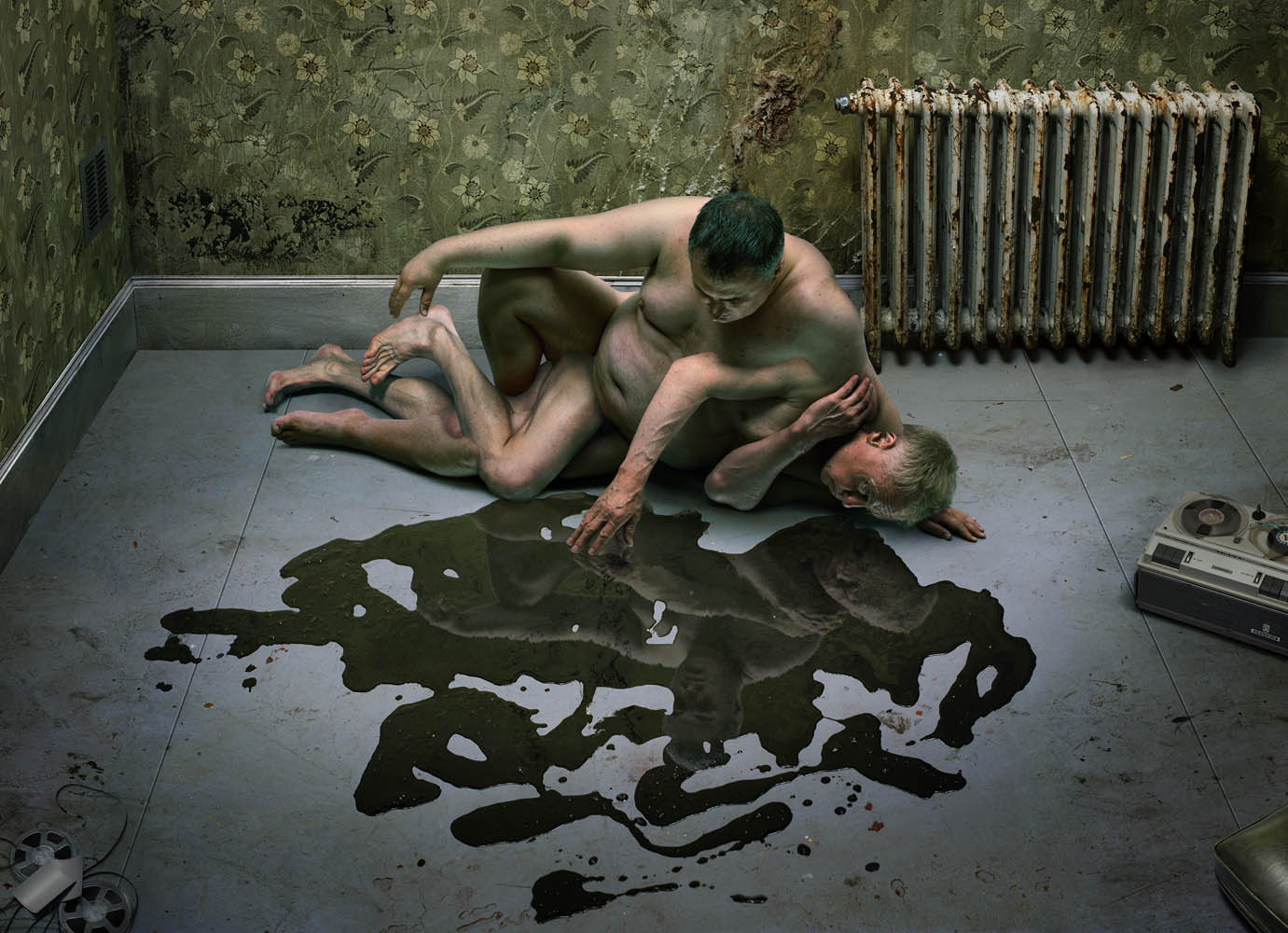
Foreign Body
Limited edition Lambda print; sizes vary.
This series of photographs, entitled ‘Foreign Body’, explore the relationship between the body and identity whilst also questioning traditional conceptions of corporeality and of the male nude.
In these pictures the body is presented as unstable, ambiguous, permeable, and lacking a singular coherent form. I depict the body not as a protective envelope that defines and unifies our limits, but rather, a place of interface between the subject and the other. The body’s boundaries are questioned and the closure and integrity of the self is placed in doubt.
Figures intersect, seeming to inhabit the same space rendering it unclear where one figure ends and another begins. This results in a kind of fragmentation and incoherence of the body leading to questions over the coherence of the self in relation to the body. The body is no longer the space that secures the idea of self, it is the domain where the self is contested and called into question.Corporeality is evoked in every aspect of the image, from the obvious physicality of the naked figures, to the decaying rooms they inhabit, the exposed pipe work and peeling wallpaper seeming to evoke wounded flesh, flaking skin and sweating bodies. The sense of the fleshiness of the world seeps beyond the boundaries of the figures into their environment – a world made flesh.
The bodies themselves are subject to unsentimental scrutiny. Every pour, wrinkle and crease is set forth. Rejecting the long tradition of the idealised nude in art history, I present the figure with all its fascinating flaws in tact. Its ageing frailty, its beautiful textures and colours, its translucent skin over pulsing blue veins all contributing to an image of the body that is rich with life and vitality and yet whose frail mortality is ever present.
Photography is a particularly appropriate medium for my purposes given its historical associations and recent digital transformation. Photography once appeared to provide us with causally generated ‘truthful’ records of things in the world. It reinforced the Cartesian idea of a disembodied self, capable of attaining certain knowledge from a stable viewpoint. In the digital age this definition of photography has collapsed, yet the belief in the photograph as a faithful record of reality stubbornly persists. I see an analogous shift in modern understandings of the self. Cartesian notions of self – stable, ordered, discrete, disembodied, permanent, unchanging – have given way to a fragmented self – unstable, constantly in flux, embodied, impermanent, fluid.
In these photographs the idea of photography as instantaneous nature of photography has been turned on its head. Taken from several points of view, composed of multiple shots, compressing several instances into a single frame, they are compositions of unified fragments. The sense of an illusory wholeness masking a fractured and uncertain reality is embedded in the very structure of the photographs and functions as a metaphor for the illusion of wholeness in the fragmented self.
-

Foreign Body
Limited edition Lambda print; sizes vary.
This series of photographs, entitled ‘Foreign Body’, explore the relationship between the body and identity whilst also questioning traditional conceptions of corporeality and of the male nude.
In these pictures the body is presented as unstable, ambiguous, permeable, and lacking a singular coherent form. I depict the body not as a protective envelope that defines and unifies our limits, but rather, a place of interface between the subject and the other. The body’s boundaries are questioned and the closure and integrity of the self is placed in doubt.
Figures intersect, seeming to inhabit the same space rendering it unclear where one figure ends and another begins. This results in a kind of fragmentation and incoherence of the body leading to questions over the coherence of the self in relation to the body. The body is no longer the space that secures the idea of self, it is the domain where the self is contested and called into question.Corporeality is evoked in every aspect of the image, from the obvious physicality of the naked figures, to the decaying rooms they inhabit, the exposed pipe work and peeling wallpaper seeming to evoke wounded flesh, flaking skin and sweating bodies. The sense of the fleshiness of the world seeps beyond the boundaries of the figures into their environment – a world made flesh.
The bodies themselves are subject to unsentimental scrutiny. Every pour, wrinkle and crease is set forth. Rejecting the long tradition of the idealised nude in art history, I present the figure with all its fascinating flaws in tact. Its ageing frailty, its beautiful textures and colours, its translucent skin over pulsing blue veins all contributing to an image of the body that is rich with life and vitality and yet whose frail mortality is ever present.
Photography is a particularly appropriate medium for my purposes given its historical associations and recent digital transformation. Photography once appeared to provide us with causally generated ‘truthful’ records of things in the world. It reinforced the Cartesian idea of a disembodied self, capable of attaining certain knowledge from a stable viewpoint. In the digital age this definition of photography has collapsed, yet the belief in the photograph as a faithful record of reality stubbornly persists. I see an analogous shift in modern understandings of the self. Cartesian notions of self – stable, ordered, discrete, disembodied, permanent, unchanging – have given way to a fragmented self – unstable, constantly in flux, embodied, impermanent, fluid.
In these photographs the idea of photography as instantaneous nature of photography has been turned on its head. Taken from several points of view, composed of multiple shots, compressing several instances into a single frame, they are compositions of unified fragments. The sense of an illusory wholeness masking a fractured and uncertain reality is embedded in the very structure of the photographs and functions as a metaphor for the illusion of wholeness in the fragmented self.
-

Foreign Body
Limited edition Lambda print; sizes vary.
This series of photographs, entitled ‘Foreign Body’, explore the relationship between the body and identity whilst also questioning traditional conceptions of corporeality and of the male nude.
In these pictures the body is presented as unstable, ambiguous, permeable, and lacking a singular coherent form. I depict the body not as a protective envelope that defines and unifies our limits, but rather, a place of interface between the subject and the other. The body’s boundaries are questioned and the closure and integrity of the self is placed in doubt.
Figures intersect, seeming to inhabit the same space rendering it unclear where one figure ends and another begins. This results in a kind of fragmentation and incoherence of the body leading to questions over the coherence of the self in relation to the body. The body is no longer the space that secures the idea of self, it is the domain where the self is contested and called into question.Corporeality is evoked in every aspect of the image, from the obvious physicality of the naked figures, to the decaying rooms they inhabit, the exposed pipe work and peeling wallpaper seeming to evoke wounded flesh, flaking skin and sweating bodies. The sense of the fleshiness of the world seeps beyond the boundaries of the figures into their environment – a world made flesh.
The bodies themselves are subject to unsentimental scrutiny. Every pour, wrinkle and crease is set forth. Rejecting the long tradition of the idealised nude in art history, I present the figure with all its fascinating flaws in tact. Its ageing frailty, its beautiful textures and colours, its translucent skin over pulsing blue veins all contributing to an image of the body that is rich with life and vitality and yet whose frail mortality is ever present.
Photography is a particularly appropriate medium for my purposes given its historical associations and recent digital transformation. Photography once appeared to provide us with causally generated ‘truthful’ records of things in the world. It reinforced the Cartesian idea of a disembodied self, capable of attaining certain knowledge from a stable viewpoint. In the digital age this definition of photography has collapsed, yet the belief in the photograph as a faithful record of reality stubbornly persists. I see an analogous shift in modern understandings of the self. Cartesian notions of self – stable, ordered, discrete, disembodied, permanent, unchanging – have given way to a fragmented self – unstable, constantly in flux, embodied, impermanent, fluid.
In these photographs the idea of photography as instantaneous nature of photography has been turned on its head. Taken from several points of view, composed of multiple shots, compressing several instances into a single frame, they are compositions of unified fragments. The sense of an illusory wholeness masking a fractured and uncertain reality is embedded in the very structure of the photographs and functions as a metaphor for the illusion of wholeness in the fragmented self.
-

Foreign Body
Limited edition Lambda print; sizes vary.
This series of photographs, entitled ‘Foreign Body’, explore the relationship between the body and identity whilst also questioning traditional conceptions of corporeality and of the male nude.
In these pictures the body is presented as unstable, ambiguous, permeable, and lacking a singular coherent form. I depict the body not as a protective envelope that defines and unifies our limits, but rather, a place of interface between the subject and the other. The body’s boundaries are questioned and the closure and integrity of the self is placed in doubt.
Figures intersect, seeming to inhabit the same space rendering it unclear where one figure ends and another begins. This results in a kind of fragmentation and incoherence of the body leading to questions over the coherence of the self in relation to the body. The body is no longer the space that secures the idea of self, it is the domain where the self is contested and called into question.Corporeality is evoked in every aspect of the image, from the obvious physicality of the naked figures, to the decaying rooms they inhabit, the exposed pipe work and peeling wallpaper seeming to evoke wounded flesh, flaking skin and sweating bodies. The sense of the fleshiness of the world seeps beyond the boundaries of the figures into their environment – a world made flesh.
The bodies themselves are subject to unsentimental scrutiny. Every pour, wrinkle and crease is set forth. Rejecting the long tradition of the idealised nude in art history, I present the figure with all its fascinating flaws in tact. Its ageing frailty, its beautiful textures and colours, its translucent skin over pulsing blue veins all contributing to an image of the body that is rich with life and vitality and yet whose frail mortality is ever present.
Photography is a particularly appropriate medium for my purposes given its historical associations and recent digital transformation. Photography once appeared to provide us with causally generated ‘truthful’ records of things in the world. It reinforced the Cartesian idea of a disembodied self, capable of attaining certain knowledge from a stable viewpoint. In the digital age this definition of photography has collapsed, yet the belief in the photograph as a faithful record of reality stubbornly persists. I see an analogous shift in modern understandings of the self. Cartesian notions of self – stable, ordered, discrete, disembodied, permanent, unchanging – have given way to a fragmented self – unstable, constantly in flux, embodied, impermanent, fluid.
In these photographs the idea of photography as instantaneous nature of photography has been turned on its head. Taken from several points of view, composed of multiple shots, compressing several instances into a single frame, they are compositions of unified fragments. The sense of an illusory wholeness masking a fractured and uncertain reality is embedded in the very structure of the photographs and functions as a metaphor for the illusion of wholeness in the fragmented self.
-
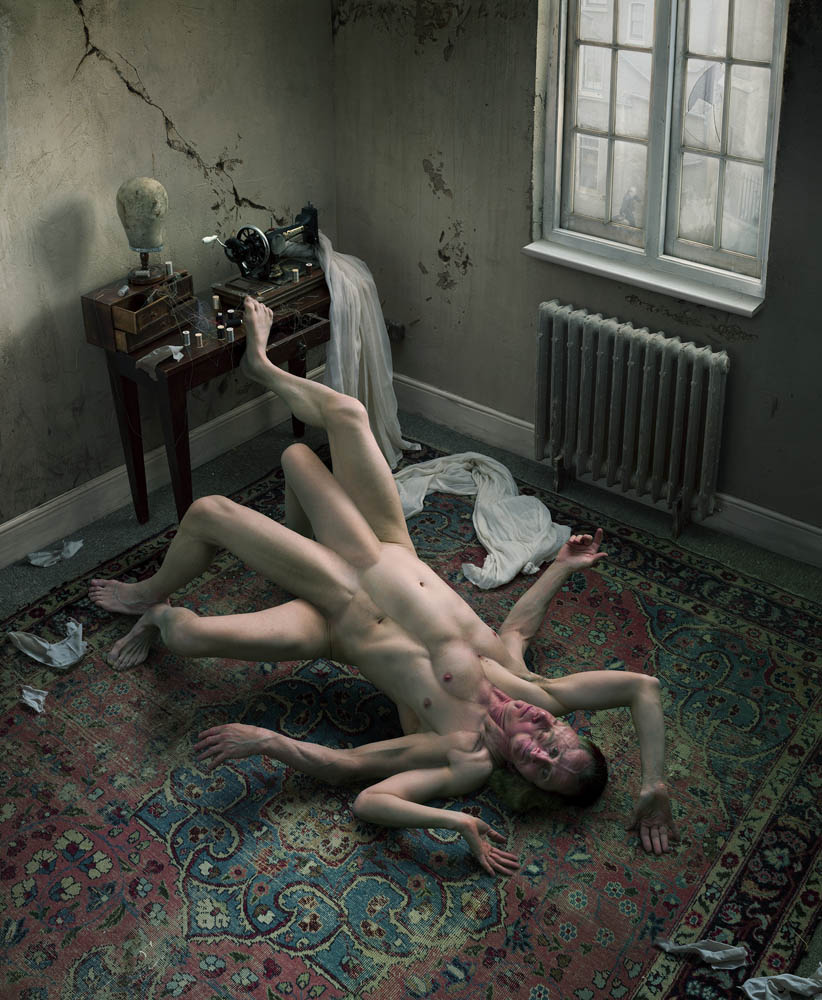
Foreign Body
Limited edition Lambda print; sizes vary.
This series of photographs, entitled ‘Foreign Body’, explore the relationship between the body and identity whilst also questioning traditional conceptions of corporeality and of the male nude.
In these pictures the body is presented as unstable, ambiguous, permeable, and lacking a singular coherent form. I depict the body not as a protective envelope that defines and unifies our limits, but rather, a place of interface between the subject and the other. The body’s boundaries are questioned and the closure and integrity of the self is placed in doubt.
Figures intersect, seeming to inhabit the same space rendering it unclear where one figure ends and another begins. This results in a kind of fragmentation and incoherence of the body leading to questions over the coherence of the self in relation to the body. The body is no longer the space that secures the idea of self, it is the domain where the self is contested and called into question.Corporeality is evoked in every aspect of the image, from the obvious physicality of the naked figures, to the decaying rooms they inhabit, the exposed pipe work and peeling wallpaper seeming to evoke wounded flesh, flaking skin and sweating bodies. The sense of the fleshiness of the world seeps beyond the boundaries of the figures into their environment – a world made flesh.
The bodies themselves are subject to unsentimental scrutiny. Every pour, wrinkle and crease is set forth. Rejecting the long tradition of the idealised nude in art history, I present the figure with all its fascinating flaws in tact. Its ageing frailty, its beautiful textures and colours, its translucent skin over pulsing blue veins all contributing to an image of the body that is rich with life and vitality and yet whose frail mortality is ever present.
Photography is a particularly appropriate medium for my purposes given its historical associations and recent digital transformation. Photography once appeared to provide us with causally generated ‘truthful’ records of things in the world. It reinforced the Cartesian idea of a disembodied self, capable of attaining certain knowledge from a stable viewpoint. In the digital age this definition of photography has collapsed, yet the belief in the photograph as a faithful record of reality stubbornly persists. I see an analogous shift in modern understandings of the self. Cartesian notions of self – stable, ordered, discrete, disembodied, permanent, unchanging – have given way to a fragmented self – unstable, constantly in flux, embodied, impermanent, fluid.
In these photographs the idea of photography as instantaneous nature of photography has been turned on its head. Taken from several points of view, composed of multiple shots, compressing several instances into a single frame, they are compositions of unified fragments. The sense of an illusory wholeness masking a fractured and uncertain reality is embedded in the very structure of the photographs and functions as a metaphor for the illusion of wholeness in the fragmented self.
-

-


